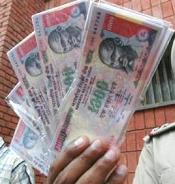 The year 2010 was a tumultuous one for micro-finance institutions (MFIs) in India. It began with the highly successful SKS Microfinance public issue, which prompted other prominent MFIs to announce similar plans.
The year 2010 was a tumultuous one for micro-finance institutions (MFIs) in India. It began with the highly successful SKS Microfinance public issue, which prompted other prominent MFIs to announce similar plans. It ended with the tumult in Andhra Pradesh which was marked by the state's legislation to regulate the sector, severely impairing its ability to survive. MFI recoveries are down and they, in turn, have fallen behind in their repayment to banks. What are the lessons?
First, all the trouble is in Andhra Pradesh. MFIs are working smoothly in other states. Those with a broader reach and more dispersed operations across states are less affected.
The basic flaw with the MFI phenomenon is its excessive concentration in one state (Andhra) and more broadly in the south. If large for-profit MFIs were to go by the fundamental principles of management, they would have started to de-risk their business long ago by spreading it more widely. So everything apart, their managements have performed poorly on this score.
Second, it is all about large for-profit MFIs. They are the ones who matter, accounting for a lion's share of MFI operations. There are innumerable self-help groups all over the country, many of them linked to banks, which are outside the pale of the controversy.
Micro-finance began with such groups and will continue with them, as long as we have the poor with us. The issue is whether for-profit MFIs, a late entrant that revolutionised micro-finance and held out the promise of rapid expansion by streamlining procedures through modern financial institution practices, will survive.
With hindsight, two realities are clear. Market mechanisms, induction of risk capital and servicing of such capital can go counter to the basic goal of attacking poverty as the marketplace has its own frailties.
Besides, it should be clear to all that micro-finance on its own cannot remove poverty. It can at best make a dent in income poverty. A setback, be it a flood or drought or illness, can and does take a family back to destitution.
For a for-profit sector to anchor its whole business model on a 98 per cent plus rate of recovery is to provoke serious scepticism.
If to this you add group guarantee and peer pressure on a defaulter, you know why suicides can happen. MFIs rightly say that not a single suicide has been investigated and linked to coercive recovery, but in the public mind the case against them rests on grounds of plausibility.
All this does not mean that the for-profit model should be abolished. It alone has brought a sea change in efficiency which has given micro-finance both scale and viability.
So, it is good to be driven by the profit motive but only up to a point. Investors in micro-finance should be happy with a lower than the market-determined rate of return.
Third, there is urgent need for effective regulation. Two entities have failed to deliver this. One is the Micro-finance Institutions Network, representing the for-profit MFIs, which has been in existence for nearly a year but is yet to bring out norms by which all can know what is the effective rate of interest charged by an MFI. This inability to promote transparency must damage the reputation of the whole tribe.
The apex institution which has failed to enforce effective regulation is the Reserve Bank of India (RBI) which is mandated to regulate for-profit MFIs that are registered as non-banking financial intermediaries and come under its supervision.
These are the big boys who matter and the poor are suffering because of the absence of effective regulation. The wrong things that happened in Andhra did so under the RBI's watch. Worse is the role of the banks.
They were happy to lend to MFIs, buy loan portfolios from them to meet their priority sector lending targets and when the trouble began, wanted to stop lending. Neither is the role of Nabard becoming. It wants to be both a regulator and promoter of micro-finance.
Fourth, the issue of excessively high rates of interest charged by for-profit MFIs is a red herring. A short-term income-generating loan, say to a vegetable seller, can be nominally high but not so to her because of the resulting income. What is important is return on assets.
By this measure, MFIs outperform banks. So they, in the aggregate, are making good money but again it is really the large MFIs which are doing so. It is RBI that has to monitor them individually and there aren't that many of them to track. The top ten account for a large share of the market.
Fifth, the regulation that we now have in Andhra is badly put together and flawed. It asks for a degree of grass roots-level registration of micro-finance operations that is impractical and hugely cumbersome.
The Andhra reaction came about for two reasons. The state functionaries got hopping mad as the field agents of for-profit MFIs began poaching on the client base of the state-sponsored micro-finance initiative which pre-dates the advent of the former.
The troubled politics of the state after the death of Rajasekhara Reddy led to micro-finance-related suicides being widely publicised, forcing the government to be seen to act.
So, large for-profit MFIs and their regulators will put controversy behind them provided they make the following new year resolutions: stop picking on low-hanging fruits in Andhra, come clean on the effective rate of interest, stop taking group guarantees and ensure hands on regulation that keeps an eye on MFI earnings so that the poor get a share of them via declining interest rates.






